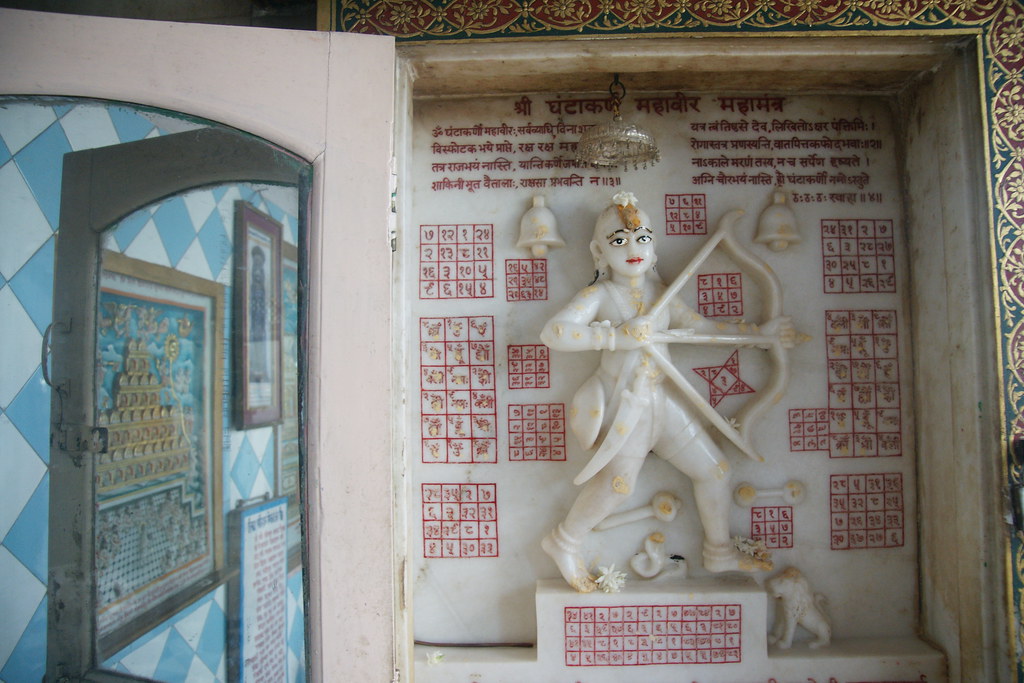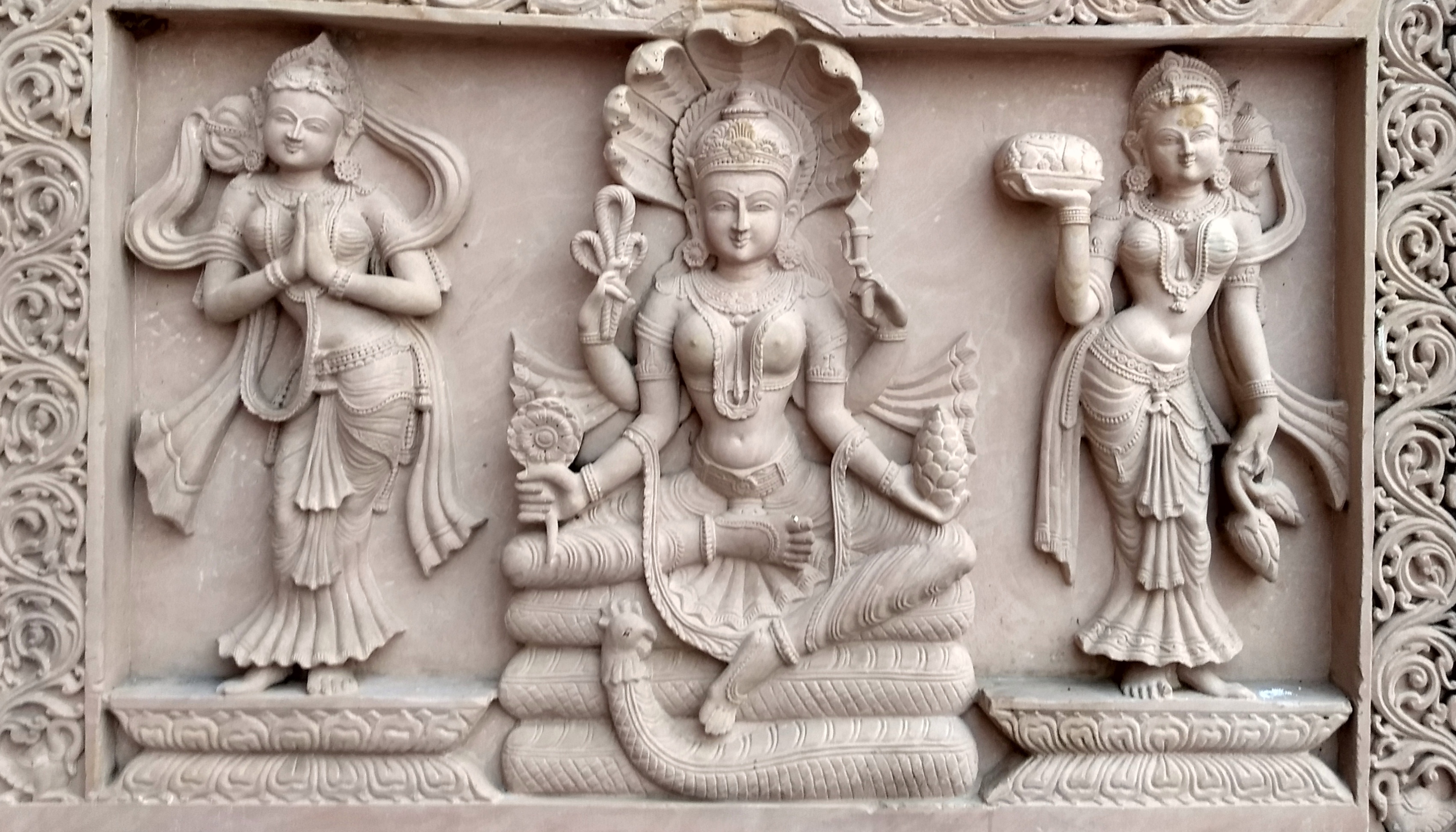This episode marks the second occasion in about as many weeks that I have found myself lamenting my lack of familiarity with Jain tantra. When asked recently whether I could identify a mandala a colleague had chanced across, I could only reply with a shrug, “I’m stumped. Must be Jain.” So while I was especially glad for a preview of Dr. Gough’s forthcoming book, let the reader beware: I am by no means an expert on Jainism. Fortunately, as this is clearly a work concerned with the notoriously slippery notion of Tantra as a distinct register of Indic religiosity —sometimes called ‘Tantrism’ to distinguish the category in the abstract from the eponymous genre(s) of revealed texts with which it is most commonly associated— we can take the conversation in that direction. I suspect Dr. Gough has already addressed many of these issues at length in her book, but for now we have at least the opportunity to savor the anticipation.
The idea of Tantra as something distinct from ‘whatever is written in the tantras’— that is, as a coherent form of esoteric Hinduism at least conceptually distinct from the Bhagavad Gita’s tripartite enumeration of [orthoprax] ritual, philosophical inquiry, and devotional worship as means of ‘union’ (yoga) with the Divine Self; and/or as a rarefied fast-track to enlightenment for the Mahayana Buddhist elite, is itself a subject of considerable controversy. For the 15th century Tibetan scholar Khedrup Gelek Pelzang, imaginatively assuming the form of a deity was the fundamental aspect of Tantra, while in the early 20th century John Woodroffe, the so-called Father of Tantric Studies, treated Tantra as synonymous with occultism. Arguably the most famous contemporary scholar of tantra, David Gordon White, asserts that “sexualized ritual practice is the sole truly distinctive feature of South Asian Tantric traditions,” and I myself have suggested that in Bengal at least, blood sacrifice is commonly taken as its most characteristic [publicly observable] feature. Presently, polythetic definitions of Tantra are probably the closest thing to the norm, or else the term itself is taken as an object for discourse analysis.1 For her part, Gough adopts the eminently defensible position that initiation into the use of mantras (revealed verbal formulae, often regarded as sonic manifestations of deities) capable of both soteriological (viz. eliminating one’s accumulated karma) and pragmatic ‘magical’ applications such as healing is fundamental. This is consonant with the longstanding tendency of Sanskrit authors to refer to Śaiva and Buddhist tantric traditions as the Path or Vehicle of Mantras (mantra-mārga/mantra-yāna), respectively.

Similarly, her observation that Jain tantra “emerges from asceticism,” though perhaps counter-intuitive in light of the prevailing assumption that many characteristically tantric practices originated in ‘tribal’ or otherwise liminal communities of non-celibate ‘exorcistic visionaries,’ actually mirrors earlier developments in the subcontinent including the way the Śaiva ascetic Ati-mārga (‘Path Beyond’) gave rise to the Mantra-mārga.2 That said, there is a surprising and somewhat perplexing idiosyncrasy in the relationship between ascetic and tantric forms of Jainism: outside of Jain contexts, there are typically separate ritual initiations into monastic life and into the use of liberatory mantras, whereas in this case a single ceremony accomplishes both. An exploration of the extent to which this rite is structurally speaking a fusion of these two forms of initiation, as opposed to ‘just’ a monastic ordination onto which the bestowal of a mantra has been appended, could show us a lot about how Jains understand (at a ritual rather than purely discursive level) the interface between what appear to be two distinct ways of neutralizing karma and its effects.
In broad, ideal-typical terms, South Asian monasticism is a process of withdrawal. The monk or nun, in theory, not only renounces their previous identity but opts out of socially-constructed personhood altogether. The restrained lifestyle of the ascetic can then be seen as an attempt to reduce one’s ‘karmic footprint’ so that meditative practices and/or bodily mortification can burn off karmic reserves. Over time, running this karmic deficit can exhaust the causes that perpetuate the cycle of life and rebirth, resulting in liberation at the time of physical death. Conversely, tantric models for liberation tend to be expansive. Although the prototypical initiation itself eradicates all non-essential karma, it immediately orchestrates the candidate’s rebirth into a divine lineage with all the privileges attendant thereto. From this point, the newly qualified initiate can and indeed must regularly employ the mantras imparted during the ceremony, effectively reenacting their initiation to fully actualize this ‘already-not-yet’ liberated state. By implication, the mantric option for dealing with karma obviates the need for asceticism, allowing the initiate to act in the world without becoming ensnared by it, and to wield deific powers as well.

“File:Trilok Teerth Dham – Exterior – Padmavati Devi.jpg” by Pratyk321 is licensed under CC BY-SA 4.0
To be sure, Indic religions tend to assume that superhuman abilities manifest naturally as a side effect of asceticism, and reports of wonder-working monks on that basis alone are commonplace. It is true too that many members of organized monastic communities also receive tantric initiations with the understanding that these traditions are complimentary, but the divergent theoretical underpinnings of ascetic and tantric practice make the apparent collapse of the two initiations in Jain contexts especially striking. And if the operative logic there is so overwhelmingly ascetic so that, as Cort writes, there is no “full-scale alternative Tantric path to liberation” in Jainism,3 we have a different problem: how to explain the efficacy of mantra without recourse to the basic theory behind tantric initiation or the [fundamentally Hindu] notion of the Sanskrit language as intrinsically capable of manipulating reality? If nothing else the conundrum illustrates once again how ritual can operate independently of doctrine.
Of course the simplest historical explanation for potential incongruities between the logic of these rituals and the larger Jain tradition is that Jains appropriated them from Śaivas while leaving behind the relevant theological underpinnings. Dr. Gough alludes to this phenomenon herself but chooses for theoretical reasons to focus here on the tantricization of particular “ritual components.” I am extremely curious to read a fuller rationale for this strategy, since it would seem as if the possibility for tracking the tantricization process in Jain contexts comes at the cost of reducing the ‘tantra- ’ part of the equation to abstract ‘ritual tech’ unmoored from history such as can be attested in dateable sources. The main risk in so doing is that tantra itself fades away into the so-called ‘Indian religious substratum’4 taking the analytic utility of tantricization with it. Conversely, if ‘tantricization’ ultimately means becoming more like things initially or most typically described in Śaiva or for that matter Vedic texts, why not just say that?
Not that I think we should allow texts to drive the conversation entirely; in fact I very much appreciate her approach of reading and indeed leading with contemporary ritual manuals and ethnography, working backwards to ‘classical’ canonical sources. The present is arguably the least arbitrary starting point for diachronic research, and the result in a case like this (though again, at the risk of sacrificing a certain kind of historicity) is more likely to be guided by a logic internal to the tradition under consideration. Based on what I’ve been able to glean from this preview, that strikes me as an advantageous trade.
References
- On the difficulty of defining Tantra, see Padoux, “What Do We Mean by Tantrism?” For Khedrup’s rather technical discussion see Mkhas-Grub Dge-Legs-Dpal-Bzan-Po, Lessing, and Wayman, Introduction to Buddhist Tantric Systems. 163-171. On Woodroffe see Strube, “Tantra as Experimental Science in the Works of John Woodroffe.” White makes the claim quoted above in Kiss of the Yoginī: “Tantric Sex” in Its South Asian Contexts. 13. On sacrifice see Bordeaux, “Blood in the Mainstream.” A recent and thorough polythetic definition can be found in the introduction to White, Tantra in practice. Urban’s post-colonial analysis of Tantra is in the introduction to Tantra.
- See Sanderson, “The Lākulas: New Evidence of a System Intermediate between Pāñcārthika Pāśupatism and Āgamic Śaivism.”
- Cort, “Worship of Bell-Ears the Great Hero, a Jain Tantric Deity.” 417.
- The debate between Sanderson and Ruegg (among others) over whether e.g. Buddhists ‘appropriated’ Śaiva tantric traditions or whether both Buddhists and Śaivas both drew on a common repertoire of deities, ideas, and practices is extensive and ongoing. Their most thorough cases are made respectively in Sanderson, “The Śaiva Age” and Ruegg, The Symbiosis of Buddhism with Brahmanism/Hinduism in South Asia and of Buddhism with “Local Cults” in Tibet and the Himalayan Region.


